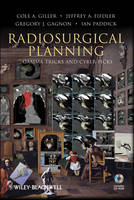
Radiosurgical Planning
Wiley-Blackwell (Verlag)
978-0-470-17556-9 (ISBN)
- Titel ist leider vergriffen;
keine Neuauflage - Artikel merken
A self-contained treatment of surgical planning forbeginners and a compendium of tips and tricks for experts Radiosurgery is a complex procedure requiring the physician to construct a radiosurgical plan, i.e., a map that tells the radiation device exactly where to aim the beams of radiation. While there are plenty of books and articles describing radiosurgery's efficacy, until now there has been no instruction manual for those who wish to learn the secrets of its execution in common practice. Radiosurgical Planning: Gamma Tricks and Cyber Picks is the first self-contained instruction manual for both beginners and experts, teaching the art and science of radiosurgery with an emphasis on the use of the Gamma Knife and the CyberKnife for treatment oflesions in both the brain and body. The authors-who together hold more than sixty years of experience in the field of radiosurgery-begin with a discussion of the general principles of radiosurgical planning, radiosurgical algorithms, and an overview of practical first steps for beginners. Next, they offer an extensive compendium of practical tricks and picks for more seasoned experts.
Included is a bonus CD-ROM that contains exercise files that can be loaded directly into the Gamma Knife planning software, as well as stand-alone simulation software that allows readers to practice radiosurgical planning without the necessity for a real radiosurgical device. Radiosurgical Planning: Gamma Tricks and Cyber Picks is an indispensable resource for physicians, medical physicists, dosimetrists, neurosurgery and radiation oncology residents, and anyone involved in the expanding field of radiosurgery.
Foreword by Douglas Kondziolka, MD. Foreword by John R. Adler, Jr., MD. Preface. Acknowledgments. Part I: General Principles of Radiosurgical Planning. 1. What Is This Book and What Is Radiosurgical Planning? Preliminaries I: Three Confessions, an Apology and a Promise. Preliminaries II: Is This Book for Beginners or Experts? Preliminaries III: What Is in This Book? The Need for a Plan. Isodose Lines and Doses. Isodose Lines Versus Isodose Shells. Nomenclature. Prescriptions to Isodose Lines: Problems. Radiosurgical Heresy: The Utility of Heterogeneity. Selection of Isodose Lines. So What is Radiosurgical Planning? 2. Introducing the Gamma Knife, Its Algorithm, and Its Strategies. The Gamma Knife. The Gamma Knife: Perfection or Perfexion? A Word About Trunnions. 3. Introducing the CyberKnife, Its Algorithm, and Its Strategies. A Different Animal: The CyberKnife. The CyberKnife: Inverse Planning. CyberKnife Parameters. A Hidden Competition. Monitor Units. 4. Compromises and Four Goals of Radiosurgical Planning. Why Every Plan Is a Compromise. Goal One: Punish the Guilty. Goal Two: Protect the Innocent. Goal Three: Guide the Heat. Goal Four: Minimize the Volume. 5. Practical First Choices. Choose to Do It Yourself. Choose the Dose, Tumor Size, and Critical Structures. Choose the Clinical Goal. Choose the Tumor. Choose the Prescription Isodose Line. Choose the Margin. Choose How to Protect the Innocent. Choose the Collimator. Choose Your Schedule. Part II: Tricks and Picks. 6. Gamma Tricks. Tricks to Get Started. Trick #1: Taking the First Shot. Trick #2: Use Lots of Shots. Trick #3: Spread Out Your Shots: Introducing Renormalization. Trick #4: Use Central Shots. Trick #5: Use All the Lines. Tricks for Geometric Building Blocks. Trick #6: The Virtual Collimator. Trick #7: The Virtual Collimator on-the-Fly. Trick #8: The Virtual Collimator Revisited. Trick #9: Making Nubbins: Renormalization Again. Trick #10: Making Ovals and Barbells. Trick #11: Making Fingers. Trick #12: Paradoxical Weighting. Trick #13: Renormalization for Large Targets. Trick #14: The Virtual Collimator Revisited Again. Tricks for Caps. Trick #15: Covering the Caps. Trick #16: Cap Weights. Tricks of Strategy. Trick #17: Divide and Switch. Trick #18: Check Collisions Early. Trick #19: Use All the Angles. Tricks for Display. Trick #20: Quick Comparisons of Different Treatments. Trick #21: Quick Comparison of Different Plans. Trick #22: Better Ways to Move Shots. Trick #23: Switch On, Switch Off. Trick #24: The DVH Calculator. Trick #25: Critical Doses at a Glance. Tricks for Contouring. Trick #26: Smart Margins. Trick #27: Influence at a Distance by Renormalization. Trick #28: Effortless Expansion and Contraction. Tricks for Managing the Heat. Trick #29: Turning Up the Heat. Trick #30: Turning Down the Heat. Trick #31: Steering the Heat I. Trick #32: Steering the Heat II. Trick #33: Steering the Heat III. Trick #34: Quenching the Heat. Trick #35: Detecting Instability. Trick #36: The Cavity Trick. Tricks for Arteriovenous Malformations. Trick #37: The Nidus-Slice Trick. Trick #38: Watch Your z !! Tricks for Shielding. Trick #39: Shields Up! Trick #40: Plug Tricks. Trick #41: How Many Plugs Exactly? Trick #42: Reaching Laterally: The Plug-Squash Trick. Trick #43: Plugs for Notches. Trick #44: The Half-Doughnut Trick: Vertical and Horizontal Shots. Tricks for Multiple Lesions. Trick #45: Tricks for Multiple Lesions. Trick #46: The Scientific Weigh. Trick #47: Top-to-Bottom Matrix Organization. Trick #48: Segregation of Collimators. Trick #49: Beware of Matrix Effects. Tricks for Trunnions. Trick #50: Whole Numbers for Trunnions. Trick #51: Use Larger Collimators. Special Tricks. Trick #52: Save Time with Fewer Groups. Trick #53: Plan Within a Plan. Trick #54: The Perfexion Trick. Trick #55: Control Your Angles with Asymmetric Plugs. Trick #56: Help from the Wizard. Tricks Especially for Perfexion. Trick #57: Understanding the Isodose Lines. Trick #58: Deceptive Symmetry. Trick #59: Hope for Skewed Targets. Trick #60: Virtual Sectors. Trick #61: Doughnuts to Perfexion: A Hypothesis. Trick #62: Corruption of Dose Gradient. Trick #63: The Time Cost of Sector Blocking. A Final, Special Gamma Knife Trick. Trick #64: Pre-planning. 7. Cyber Picks. Fusion Picks. Pick #1: Plant the Right Seed. Pick #2: Mental Fusion. Tricks for Setup. Pick #3: Smart Centering. Pick #4: Collimator Size: Simplicity. Pick #5: Collimator Size: Complexity. Pick #6: Optimal Matrices. Tricks for Outlining. Pick #7: Choose Your Margins: Tumors. Pick #8: Combining CT and MRI. Pick #9: Make Realistic Contours. Tricks to Set Dose. Pick #10: Mastering Dose Ratios. Pick #11: Stubborn Isodose Lines. Tricks to Boost Dose. Pick #12: The Power of Small Collimators. Pick #13: Forcing the Low-Isodose Line. Tricks to Constrain Dose. Pick #14: Start Simple. Pick #15: Beam Me Off! Pick #16: Control Dose with a Margin Call. Pick #17: A Shell Game. Pick #18: Anisotropy to the Rescue: Lopsided Margin Structures. Pick #19: Ultimate Control of Dose with Shells and Margins. Pick #20: Protecting the Innocent with Buffer Zones. Pick #21: Splitting Critical Structures. Pick #22: Separating Targets. Tricks for Conformality. Pick #23: Splitting Targets. Pick #24: Look Under the Hood. Pick #25: Trim a Little Off the Top, Please. Pick #26: Adding a Blip. Pick #27: Equal Dose Points. Pick #28: Turn Them Upside Down. Pick #29: Optimal Number of Beams. Special Tricks. Pick #30: Plan Within a Plan. Trick #31: The Doughnut Trick. Tricks for Safety. Pick #32: Grid Size Matters. Pick #33: Beware Invisible Organs. Tricks for Strategy. Pick #34: Keep It Simple. Pick #35: Relax Your Constraints. Pick #36: Sparse Grids. Pick #37: Non-isocentric May Not Be Best. Pick #38: What to Tell Your Physicist. Tricks for Scheduling. Pick #39: Keeping Track of Treatment Time. Pick #40: Schedules and Humans. Tricks for Fun. Pick #41: Surface Points Only? Part III: Parting Shots: How the Culture of Radiosurgery Affects Radiosurgical Planning. 8. Radiosurgery as a Human Effort. The Neurosurgeon. The Radiation Oncologist. The Physicist. The Physicist (The UK Perspective). References. Appendixes. Appendix I: Site of Maximum Dose of Two Shots of Unequal Size. Appendix II: Exercises for Gamma Knife Radiosurgical Planning. Appendix III: Tutorial for the Gamma Knife Simulator. Index.
| Erscheint lt. Verlag | 30.7.2009 |
|---|---|
| Zusatzinfo | Illustrations |
| Verlagsort | Hoboken |
| Sprache | englisch |
| Maße | 179 x 260 mm |
| Gewicht | 642 g |
| Themenwelt | Medizinische Fachgebiete ► Chirurgie ► Neurochirurgie |
| Medizinische Fachgebiete ► Radiologie / Bildgebende Verfahren ► Neuroradiologie | |
| Medizinische Fachgebiete ► Radiologie / Bildgebende Verfahren ► Radiologie | |
| ISBN-10 | 0-470-17556-7 / 0470175567 |
| ISBN-13 | 978-0-470-17556-9 / 9780470175569 |
| Zustand | Neuware |
| Haben Sie eine Frage zum Produkt? |
aus dem Bereich


